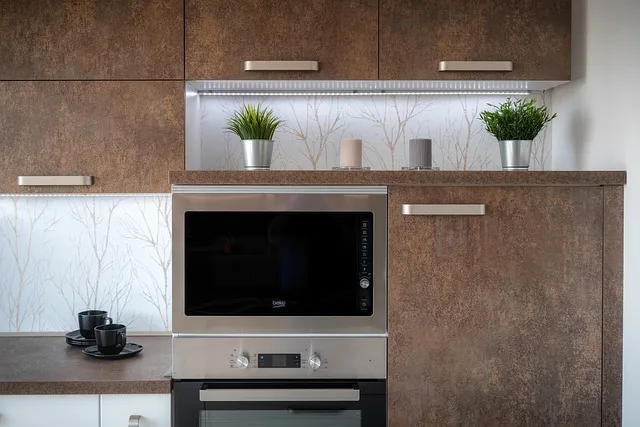Think of painted cabinets as the vibrant canvas of a masterpiece, while the wood trim acts as the elegant frame that ties everything together. The key is to find the right balance. If you choose bold colors for your cabinets, like a deep navy or a cheerful yellow, the natural warmth of wood trim can soften the look, making it feel inviting rather than overwhelming. It’s like pairing a bright dress with a classic leather jacket—suddenly, you have a style that’s both chic and approachable.
Now, let’s talk about texture. Painted cabinets offer a sleek, modern vibe, while wood trim brings in that rustic charm. This mix can create a dynamic kitchen that feels both contemporary and timeless. Picture a glossy white cabinet with rich oak trim; it’s a match made in design heaven! Plus, the wood trim can highlight architectural features, drawing the eye and adding depth to your kitchen.
And don’t forget about the color palette! If your cabinets are painted in soft pastels, a lighter wood trim can enhance that airy feel. On the flip side, dark cabinets paired with a darker wood trim can evoke a sense of sophistication and drama. It’s all about how you want your kitchen to feel. So, whether you’re going for a farmhouse vibe or a sleek modern look, painted cabinets and wood trim can work together beautifully, creating a space that’s uniquely yours.
The Perfect Pair: How Painted Kitchen Cabinets and Wood Trim Create Timeless Elegance
Now, let’s talk about wood trim. It’s the unsung hero of kitchen design, adding depth and character that painted cabinets alone can’t achieve. Think of it as the frame around a beautiful painting—it enhances the overall picture. Whether it’s a sleek, contemporary molding or a rustic farmhouse style, wood trim brings warmth and texture, creating a stunning contrast against the smooth finish of painted cabinets.
Have you ever noticed how a well-placed piece of trim can draw the eye and elevate the entire space? It’s like adding a cherry on top of a sundae. The interplay between the painted surfaces and the natural grain of the wood creates a visual feast that’s both inviting and sophisticated. Plus, the combination is incredibly practical. Painted cabinets are easy to clean and maintain, while wood trim adds durability and a touch of luxury.
From Drab to Fab: Transform Your Kitchen with Painted Cabinets and Wood Accents
First off, let’s talk about painted cabinets. Swapping out that tired, outdated color for something bold or soft can completely change the vibe of your kitchen. Think of it as giving your cabinets a new wardrobe. Whether you opt for a chic navy blue or a soft sage green, the right color can make your kitchen feel like a whole new world. Plus, painting cabinets is a DIY project that can save you a ton of cash compared to a full remodel. It’s like giving your kitchen a facelift without the hefty price tag!
Now, let’s sprinkle in some wood accents. Picture this: warm wooden shelves or a rustic butcher block countertop. These elements add depth and texture, creating a cozy atmosphere that’s perfect for family gatherings or casual brunches with friends. Wood accents can act like the perfect accessory, complementing your painted cabinets and tying the whole look together. It’s like adding the cherry on top of a delicious sundae!
Mixing Materials: The Surprising Harmony of Painted Cabinets and Wood Trim
When you think about it, painted cabinets are like the life of the party—bright, bold, and full of personality. They can be anything from a soft pastel to a striking navy, setting the mood for your entire kitchen. Now, throw in some wood trim, and you’ve got a match made in design heaven. The wood adds depth and texture, grounding the vibrant colors and creating a balanced aesthetic. It’s like adding a dash of salt to a sweet dish; it elevates the flavors and brings everything together.
But how do you achieve this harmony? Start by choosing a color palette that speaks to you. If your cabinets are a lively teal, consider a warm oak trim to soften the look. Or, if you’re going for a classic white cabinet, a rich mahogany trim can add that touch of elegance. The key is to ensure that the colors and textures complement each other, creating a cohesive look that feels intentional.
Design Dilemma: Can Painted Kitchen Cabinets and Wood Trim Coexist Beautifully?
Imagine walking into a kitchen where the soft hues of painted cabinets catch your eye, while the rich, natural tones of wood trim frame the space like a cozy hug. It’s all about balance. If you go for a bold color on your cabinets, consider a lighter wood trim to soften the look. Think of it as a dance; the painted cabinets lead with their vibrant energy, while the wood trim provides a steady rhythm that grounds the design.
But how do you make this duo work? Start by choosing a color palette that harmonizes both elements. A muted blue or soft gray can beautifully complement the warmth of oak or walnut trim. And don’t shy away from mixing textures! A matte finish on your cabinets can contrast beautifully with the glossy sheen of polished wood, creating visual interest that keeps the eye moving.
A Match Made in Design Heaven: Exploring the Aesthetic of Painted Cabinets with Wood Trim

Let’s dive into why this combination is such a showstopper. Painted cabinets bring a splash of personality to your space. Whether you opt for a soft pastel or a bold jewel tone, the color can set the mood of the entire room. It’s like adding a splash of paint to a canvas; suddenly, the whole picture comes alive! Now, when you introduce wood trim, you’re adding depth and texture. The natural grain of the wood contrasts beautifully with the smooth finish of the paint, creating a visual feast for the eyes.
Think about it: the warmth of wood evokes a sense of comfort, while the painted surfaces can reflect your unique style. It’s a balance that feels both inviting and sophisticated. Plus, this combo is incredibly versatile. Whether your home leans toward modern minimalism or rustic charm, painted cabinets with wood trim can adapt and shine in any setting.
Wood Meets Color: The Trend of Combining Painted Cabinets with Natural Wood Trim
Think about it: wood brings that earthy, organic feel, while color adds personality and flair. It’s a match made in design heaven! Picture a serene blue cabinet paired with rich walnut trim. The contrast is striking, yet harmonious, creating a space that feels both inviting and stylish. It’s like having a canvas where nature and creativity collide, allowing you to express your unique taste.

But why stop at just one color? The beauty of this trend is its versatility. You can mix and match shades to create a playful vibe or stick to muted tones for a more sophisticated look. It’s all about what resonates with you. Plus, the natural wood trim acts as a grounding element, balancing out the boldness of painted cabinets. It’s like adding a dash of salt to your favorite dish—just the right amount enhances the flavor!
And let’s not forget about the practical side. Painted cabinets are easier to refresh than replacing entire wood structures. If you ever feel like changing things up, a quick coat of paint can transform your space without breaking the bank. It’s a win-win!
So, whether you’re a fan of rustic charm or modern elegance, the combination of painted cabinets with natural wood trim offers endless possibilities. It’s a trend that invites creativity and warmth into your home, making every meal feel like a special occasion. Who wouldn’t want that?
Frequently Asked Questions
Can Painted Cabinets Complement Wood Trim?
Painted cabinets can enhance the aesthetic of wood trim by providing a modern contrast while highlighting the natural beauty of the wood. The combination can create a balanced look, adding depth and character to a space. Choosing complementary colors and finishes ensures harmony between the painted surfaces and the wood trim.
Do Painted Cabinets and Wood Trim Require Matching Styles?
Matching styles for painted cabinets and wood trim are not mandatory, but consistency can enhance the overall aesthetic of a space. Choosing complementary colors and finishes can create a cohesive look, while contrasting styles can add visual interest. Ultimately, the decision should align with your design vision and personal preference.
What Color Combinations Work Best with Wood Trim?
When choosing colors to complement wood trim, consider warm tones like creams, soft whites, and muted pastels for a harmonious look. Earthy shades such as olive green, terracotta, and warm grays can enhance the natural beauty of the wood. For a bolder contrast, deep blues or rich jewel tones can create a striking effect. Always test samples in your space to see how lighting affects the colors.
How to Choose the Right Paint Finish for Cabinets and Trim?
Selecting the appropriate paint finish for cabinets and trim involves considering durability, sheen, and the desired aesthetic. For high-traffic areas, opt for semi-gloss or gloss finishes, as they are more resistant to wear and easier to clean. Satin finishes offer a softer look while still providing some durability. Matte finishes can create a modern appearance but may require more maintenance. Always test samples in your space to see how they interact with lighting and existing decor.
What Are the Pros and Cons of Mixing Painted Cabinets with Wood Trim?
Combining painted cabinets with wood trim can enhance the aesthetic appeal of a space, offering a modern yet warm look. The pros include increased visual interest, the ability to customize colors, and the potential to highlight architectural features. However, cons may involve the challenge of coordinating colors, potential for clashing styles, and the need for careful maintenance to prevent wear on both surfaces. Balancing these elements is key to achieving a cohesive design.